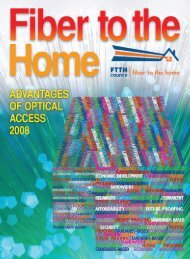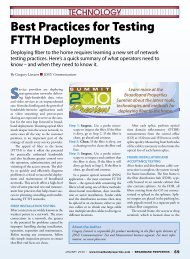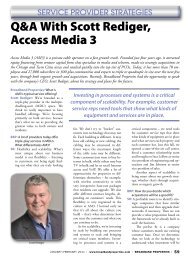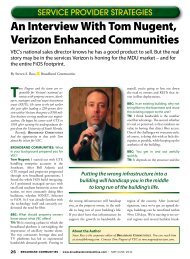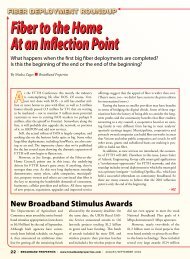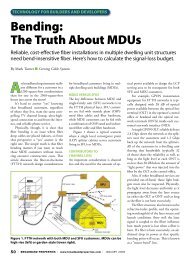bbpmag.com - Broadband Properties
bbpmag.com - Broadband Properties
bbpmag.com - Broadband Properties
Create successful ePaper yourself
Turn your PDF publications into a flip-book with our unique Google optimized e-Paper software.
According to Stanford University professor<br />
Dr. Alan Greene, 210 million Americans are<br />
without access to a doctor on the day they<br />
need one. When they do see a doctor,<br />
the average time they spend with the doctor<br />
during an office visit is 7.5 minutes.<br />
There is an overwhelming amount<br />
of biased, generic or outright incorrect<br />
health-related information available to<br />
consumers on the Web, on TV and in<br />
print. This is producing anxiety among<br />
consumers, who are be<strong>com</strong>ing increasingly<br />
responsible for health care decision<br />
making and cost sharing. Based on this<br />
information, many patients diagnose<br />
themselves inappropriately, ending up<br />
by spending money on ineffective treatments,<br />
medications, supplies, and physician<br />
and emergency room visits. In our<br />
health service assessments, 93 percent<br />
of the respondents doing online health<br />
research said they would prefer to have<br />
a live conversation with a doctor during<br />
these online sessions to review, discuss<br />
or suggest alternatives to the information<br />
they find.<br />
Consumers need a third option –<br />
health care that is easily accessible, responsive<br />
and effective. Property managers<br />
and <strong>com</strong>munication service providers<br />
are advantageously positioned to meet<br />
this significant, and growing, need.<br />
According to Parks Associates analyst<br />
Harry Wang, “Service providers are in<br />
a unique, once-in-a-lifetime position to<br />
enter and service this growing service<br />
industry. The home will be the central<br />
location in the new preventative care<br />
model in health care applications, with<br />
broadband enabling home medical services,<br />
telemedicine applications and patient<br />
monitoring.”<br />
Based on our early results, we think<br />
consumers will use this “third option”<br />
for a number of purposes, including getting<br />
second opinions; gaining a deeper<br />
understanding of their medical conditions<br />
or the treatments they’ve been prescribed;<br />
finding out whether they need<br />
emergency help for sudden-onset pain<br />
or other symptoms; and seeking advice<br />
about alternative or <strong>com</strong>plementary<br />
treatments their primary doctors may<br />
not have told them about.<br />
Many providers are already getting<br />
ready to meet this demand. In a poll<br />
that I took during a FTTH Council webinar<br />
in December 2008, 21 percent of<br />
participants indicated they were evaluating<br />
or finalizing plans for rolling out<br />
health and wellness services in 2009.<br />
Videoconferencing with doctors was the<br />
service that generated the highest level<br />
of interest (92 percent).<br />
Advantages to Network Owners<br />
By providing online health and wellness<br />
services to residents and subscribers,<br />
property developers and managers and<br />
<strong>com</strong>munication service providers can<br />
generate additional revenue streams.<br />
Health care affects 100 percent of residents<br />
and subscribers, and the demand<br />
for improved health services will only<br />
Telemedicine<br />
increase in the years ahead. Health care<br />
demand, while not quite recession-proof,<br />
is not driven by economic cycles. In fact,<br />
history has shown that during recessionary<br />
periods the shift of responsibility for<br />
health care services to consumers accelerates.<br />
The current economic downturn<br />
is unlikely to be an exception.<br />
Video consultation services offer<br />
property managers and network operators<br />
several new revenue streams without<br />
incurring any capital expenditures.<br />
By simply adding a video channel or a<br />
link on the <strong>com</strong>munity portal, they can<br />
collect a percentage of:<br />
• each video consultation fee<br />
• each subscription purchased<br />
• sales of equipment, supplies, vitamins,<br />
etc.; and<br />
• advertising revenues.<br />
Our health service assessments indicate<br />
that residents are indeed willing to<br />
pay for such services. Forty-four percent<br />
of respondents said they “probably” or<br />
“definitely” would purchase an Internet<br />
or cable TV package that included the<br />
MedConcierge TV service over one that<br />
didn’t, and another 33 percent would<br />
consider it, based on further information.<br />
In addition, nearly a third of respondents<br />
“probably” or “definitely”<br />
would pay for a service that enables live<br />
Video Consultations with Doctors<br />
Can Save Money for Consumers<br />
Even avoiding a few unnecessary emergency room visits could be extremely<br />
beneficial for consumers. Out-of-pocket costs for an office or ER<br />
visit, including travel expenses, average $696 nationally; for persons age<br />
45 – 64, the average cost for an ER visit was $832 in 2003 (according to the<br />
Agency for Healthcare Research and Quality) and is certainly much higher<br />
today. Time savings are also significant: Average ER wait time was 56 minutes<br />
in 2006 and is growing as more people use the ER as their primary<br />
source of care and as the number of ERs declines. (According to the Centers<br />
for Disease Control, ER usage increased by 32 percent from 1996 to 2006,<br />
while the number of ERs fell from 4,900 to below 4,600.)<br />
In a 2008 study by Milliman, a health care actuarial firm, videoconferencing<br />
with doctors was shown to save employers, insurers and the<br />
government between $3.36 and $6.96 per member per month in health<br />
care costs. The majority of savings are in non-emergent ER visits and inperson<br />
physician visits. Other areas of potential savings that are still under<br />
study include chronic disease management, early disease detection and<br />
care management.<br />
January/February 2009 | www.broadbandproperties.<strong>com</strong> | BROADBAND PROPERTIES | 47



